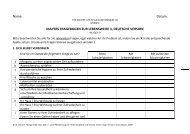Abstracts - York St John University
Abstracts - York St John University
Abstracts - York St John University
You also want an ePaper? Increase the reach of your titles
YUMPU automatically turns print PDFs into web optimized ePapers that Google loves.
Introduction: Nomads, Hybrid Spaces, Liquid Architectures, And Online<br />
Domains<br />
Eirini Nedelkopoulou (<strong>York</strong> <strong>St</strong> <strong>John</strong> <strong>University</strong>)& Maria Chatzichristodoulou (<strong>University</strong> of<br />
Hull)<br />
Eirini Nedelkopoulou is Lecturer in Theatre at <strong>York</strong> <strong>St</strong> <strong>John</strong> <strong>University</strong>. She has published<br />
on digital practices in performance, participation and new media theatre through the scope<br />
of phenomenology and theories of perception and embodiment. Eirini is co-‐editor of a<br />
forthcoming special issue of International Journal of Performance Arts & Digital Media<br />
(Intellect Press) on “Hybridity: The intersections between Performance and Science”. She is<br />
currently working on a co-‐edited book project, which explores the interventions between<br />
phenomenology and performance. She is co-‐convenor of TaPRA’s Performance and New<br />
Technologies Working Group.<br />
Maria Chatzichristodoulou [aka Maria X] is a cultural practitioner (curator, performer,<br />
producer, writer) and Lecturer in Performance and New Media at the Department of<br />
Drama and Music (Drama), <strong>University</strong> of Hull. Maria worked as a Community Officer at The<br />
Albany in South London. She was co-‐founder of the international media art festival<br />
Medi@terra and co-‐director of Fournos Centre for Digital Culture (1996-‐2002, Athens,<br />
Greece); co-‐director of the festival and symposium Intimacy Across Visceral and Digital<br />
Performance (London, 2007); director of the symposium Black Box to Second Life: Theatre<br />
and Performance in Virtual Worlds (Scarborough, 2011), and co-‐convener of the<br />
conference Live Interfaces (Leeds, 2012). Maria is co-‐editor of the volumes Interfaces of<br />
Performance (Ashgate, 2009) and Intimacy Across Visceral and Digital Performance<br />
(Palgrave MacMillan). She has lectured and published widely, including journal articles,<br />
book chapters and invited lectures at MIT, Yale <strong>University</strong> and Georgia Institute of<br />
Technology (USA). She is currently working on a monograph which explores performance<br />
practices that develop within networked environments.<br />
Keynote Address: Becoming martyr in the age of digital technology<br />
Maaike Bleeker (Utrecht <strong>University</strong>)<br />
The global emergence of technological media and electronic networks has caused an<br />
epochal shift in the citational network of discourses and turned Derrida´s iterability into a<br />
condition of life. As Jon McKenzie (Perform or Else, 22) puts it: ` Highly localized ensembles<br />
of words and gestures can now be broken apart, recombined and hyperlinked to different<br />
ensembles in ways unlike anything in the past at speeds incredible from all perspectives<br />
except those of the future.` These perspectives from the future will be my concern, and how<br />
they are part of the ‘becoming nomad’ of subjects, bodies and ideas that occurs within our<br />
contemporary globalised, mediatised, augmented and distributed environments. Such<br />
becoming nomad, I will argue, is not merely a matter of freedom and liberation but also,<br />
and at the same time, ´necessarily implies a certain level of terror, whether soft or hard: be<br />
operational (that is: commensurable) or disappear´ (Lyotard, The Postmodern Condition,<br />
xxiv).<br />
I will approach this subject and the questions it raises from a work by Lebanese<br />
performance maker Rabih Mroué, titled On Three Posters. Reflection on a video-performance<br />
by Rabih Mroué. In this video lecture Mroué reflects on an earlier work he created together<br />
with Elias Khoury, titled Three Posters. This performance in its turn presented an embodied<br />
reflection on the video tapes left behind by a Lebanese freedom fighter. These tapes, as<br />
Mroué observes, present the freedom fighter as the martyr he would become and thus<br />
produce the proof of something that had not happened yet at the time of the recording.<br />
1
This potential of video recordings to perform something that was not yet there would later<br />
be the reason that Mroué decided to stop performing Three Posters when after 9/11 the<br />
audience started to see the video testimonies in a different way. This potential however, I<br />
will argue, is characteristic for how in a situation of ´incredulity towards metanarratives´<br />
(Lyotard) performativity replaces traditional goals of knowledge, truth and liberation. In<br />
this situation, the performance of the freedom fighter trembling in the face of the camera<br />
that will challenge him forth as martyr, is the example par excellence of the terror observed<br />
by Lyotard, the terror described by McKenzie as the pressure to perform-‐-‐or else.<br />
Maaike Bleeker is a professor of Theatre <strong>St</strong>udies at Utrecht <strong>University</strong>. She graduated in<br />
Art History, Theatre <strong>St</strong>udies and Philosophy and received her PhD from the Amsterdam<br />
School for Cultural Analysis. She combines her academic work with a practice as<br />
dramaturge in theatre and dance. She is the author of Visuality in the Theatre. The Locus of<br />
Looking (Palgrave MacMillan) and editor of (among others) Anatomy Live. Performance<br />
and the Operating Theatre. She is President of Performance <strong>St</strong>udies international (PSi).<br />
Panel 1. Liquid Spaces, Performative Architectures<br />
Concepts towards the realisation of the Technophenomenological Being: the liquid<br />
dimensionality of kinaesthetic self and immersive worlds<br />
Craig Vear (De Montfort <strong>University</strong>)<br />
This paper will discuss current research in the development of a performance concept of<br />
the Technophenomenological Being; a theoretical concept inspired by Amelia Jones’ notion<br />
of the ‘metaphysical transcendence of mind-‐expanding machines’ (Jones 1998: 205). It will<br />
discuss this concept from three perspectives: 1) the development of a technically mediated<br />
environment using immersive VR and binaural sound image; 2) Natural Interfaces for fluid<br />
immersion, and 3) a framework for the cognitive-‐creative development of the performer.<br />
It will draw together seemingly disparate discourse from audience modalities of Digital<br />
Opera, performance practice of hyper-‐instruments, fluid immersion in online gaming and<br />
McGonigal’s notion of the gaming Gesamtkunstwerk, linking into philosophical frameworks<br />
from Antonio Damasio’s work into consciousness and Merleau-‐Ponty’s phenomenology<br />
including the question ‘where are we to put the limit between body and the world, since<br />
the world is flesh?’<br />
Drawing these together with current practice-‐as-‐research from the Intermediality and<br />
Performance Research Group (De Montfort <strong>University</strong>), I aim to articulate my imperative<br />
and arrive at the concept of the Technophenomenological Being that is not dwelling “within”<br />
the relationship between technology and human performer (such as juxtaposition) or<br />
“among” this relationship (such as a second skin) or even the “prosthetic God”; but is rather<br />
as.<br />
Craig Vear is a senior lecturer in Performing Arts specialising in music and digital arts<br />
within the School of Art. He is an internationally recognised composer working within<br />
performance and technology. He is chair of the Intermediality and Performance research<br />
group and full member of the DORG: Digital Opera Research Group, and MTI: Music,<br />
Technology and Innovation. He won an Olivier award in 2012, went to Antarctica as<br />
composer-‐in-‐residence with the British Antarctic Survey (2003-‐4), and sold over 350,000<br />
albums with his band Cousteau.<br />
Cartesian Bodies and Euclidean Spaces<br />
2
Sita Popat (<strong>University</strong> of Leeds)<br />
This paper considers how the use of screens within dance performances and installations<br />
affects the ways in which audiences and participants experience bodies in space. The<br />
discussion references mixed reality in recognition of how digital technologies are becoming<br />
increasingly embedded in our social and cultural experiences. The question is not what is<br />
virtual and what is physical, but rather how do combinations of light and flesh engage us in<br />
mixed reality experiences and what might be the inherent spatial narratives that underpin<br />
that engagement?<br />
Three dance or dance-‐related examples are examined in detail: Cunningham’s Biped<br />
(1999), igloo’s SwanQuake: House (2008) and Sermon’s Telematic Dreaming (1994). In each<br />
case, the virtual reality of screen space is not independent of the physical reality of the<br />
dancer or the spectator. Biped presents a stage world in which physical and virtual dancers<br />
appear to co-‐exist in a single mixed reality space. In SwanQuake: House, the visitor is<br />
invited to explore virtual and physical environments that intersect and overlap. In the 1994<br />
version of Telematic Dreaming, performer Susan Kozel extends her body in virtual form to<br />
dance with spectators via a projection onto a bed within a gallery space. These pieces use a<br />
range of approaches to the body and the screen that highlight particular relationships,<br />
employing and sometimes challenging Euclidean and relational space and Newtonian<br />
physics. It is proposed that there tend to be two ways of designing virtual reality – a realist<br />
perspective that aims for an environment that is comparable to the physical world and an<br />
alternative mode that highlights things that can only exist in the virtual world – yet both of<br />
these can easily create binaries that disrupt embodied experiences. The paper concludes by<br />
suggesting that dance has much to offer in developing understandings of how the body and<br />
technology can manage existing binaries to co-‐habit within a mixed reality environment.<br />
Sita Popat is Professor of Performance and Technology at the <strong>University</strong> of Leeds. She<br />
came into academia through dance, and her research focuses on the body and digital media<br />
in performance. She is the author of 'Invisible Connections: Dance, Choreography and<br />
Internet Communities' (Routledge 2006) and co-‐editor of 'Performance Perspectives: A<br />
Critical Introduction' (Palgrave 2011). She is Associate Editor of the 'International Journal<br />
of Performance Arts and Digital Media'. In her spare time, she enjoys playing World of<br />
Warcraft with her sons.<br />
Architectures of Youth: Visibility, Agency and the Technological Imaginings of Young<br />
People<br />
Helen Thornham (<strong>University</strong> of Leeds)<br />
Drawing on audio-‐visual data from a research project, this paper explores the constructions<br />
of a particular local environment by young people as it emerged in our research project, and<br />
how this relates to wider conceptions of youth as, and within, a particular kind of ‘space’.<br />
Utilising arguments from cultural geography, youth, education and media theory, we argue<br />
that the audio-‐visual material produced through our research plays a key role in the<br />
productive generation of meaning for the school. In turn, this introduces a further set of<br />
critical issues. First, the role of technology in generating meaning needs attention,<br />
specifically in terms of the forms/modes of intervention facilitated by audio-‐visual<br />
technology, and how we might interpret this in relation to young people. Second, the<br />
technology and the architecture of the school support and produce the visual as the<br />
powerful force that facilitates and curtails certain behaviours and performances. This has a<br />
range of wider social and cultural implications that need addressing, not least in relation to<br />
3
how it constructs and produces certain modes of behaviour. Finally, the visual recordings<br />
produced by the research participants demonstrate that the behaviours and performances<br />
are part and parcel of complex, routine and routinised engagements with the building.<br />
These performances are shaped by a range of factors including place, space, mobility,<br />
agency, power and the visual, and are constantly rearticulated and reimagined in ways that<br />
suggests we understand such buildings and the relations within them, not as static or fixed,<br />
but as ‘events’ (Rose et al 2010: 346), as ‘mobile’ (Grosz 2001:7) or as ‘process’ (Burke &<br />
Grosvenor 2008: 185-‐6).<br />
Helen Thornham is Research Fellow at the Institute of Communications <strong>St</strong>udies, <strong>University</strong><br />
of Leeds. She is the author of Ethnographies of the Videogame: Narrative, Gender and Praxis<br />
(2011) and co-‐editor of two volumes out in 2013: Renewing Feminisms: Radical Narratives,<br />
Futures and Fantasies in Media <strong>St</strong>udies (with Elke Weissmann, Edgehill) and Content<br />
Cultures: Transformations of User Generated Content in Public Service Broadcasting (with<br />
Simon Popple, <strong>University</strong> of Leeds) Her research focuses on gender and mediations,<br />
narrative, discourse and power and she is currently leading a Network+ within the Digital<br />
Economy theme (EPSRC/RCUK) investigating the digital transformations of communities<br />
and culture.<br />
Performing Lost Space: discussing an exercise in recording architectural detail with<br />
the performing body<br />
Angela Bartram & Douglas Gittens (<strong>University</strong> of Lincoln)<br />
The interior of the contemporary art space provides its users with a sterilised laboratory<br />
for the placement and experience of art. Increasingly, its bleached interior presents an a<br />
priori condition for the legitimate assignment of artworks within the complex milieu of the<br />
contemporary city. Such interiors have become an architectural typology, a predetermined<br />
homogenous non-‐place within which artworks reside. In this sense we can look to Lefebvre<br />
to understand the condition of the gallery space for ‘inasmuch as abstract space tends<br />
towards homogeneity, towards the elimination of existing differences or peculiarities, a<br />
new space cannot be born (produced) unless it accentuates differences.’ (Lefebvre: 1991,<br />
52) The work of the artist, by contrast, liberates difference. More specifically, the art of<br />
performance simultaneously generates and exposes marginal space within the gallery<br />
interior; a corporeal action that deposits residual stains and blemishes across the galleries<br />
internal skin, leaving marks and traces that resist homogeneity to create a temporary site<br />
of differential experience. The lost, forgotten or overlooked marginal zones and<br />
irregularities of a gallery space become a point of ephemeral spectacle and this paper<br />
addresses the impact of this spatial and corporeal collision.<br />
The research that informs and situates these phenomena traces the irregularities,<br />
blemishes and scars that resist conventional mapping; marks that exist within an<br />
alternative, unconventional and unbleached space before, during and after a performance<br />
act. Recorded through orthographic drawing conventions, the research generated a<br />
narrative cartography of corporeal intervention within the interior of X Church Slumgothic,<br />
a heavily used semi-‐decayed community art space in Gainsborough. The co-‐authors of this<br />
research formed a practical collaboration that fused the dynamics and complexities of the<br />
performer’s body with the fixed conventions of architectural drawings. The discussion in<br />
this paper between performer and draughtsman explores how the body becomes an<br />
instrument to record and describe an arts interior beyond, yet from within, traditional<br />
architectural systems of representation.<br />
Douglas Gittens is an architectural designer and senior lecturer in the School of<br />
4
Architecture at the <strong>University</strong> of Lincoln. ‘Liminal’, ‘absurd’, ‘differential’ and ‘marginal’<br />
space are terms that are often attributed to interstitial domains where spatial codifications<br />
merge, slip or distort, and it is within this tradition that his research finds a conceptual fix.<br />
Angela Bartram is an exhibiting artist who also writes and publishes. This work concerns<br />
conceptual and physical thresholds and the notion of animality as acted and/or intuitively<br />
behaved by humans. She is a senior lecturer in fine art at the <strong>University</strong> of Lincoln.<br />
Panel 2. Dispersed Intimacies<br />
Dissolve<br />
Julian Maynard Smith (Royal Central School of Speech and Drama)<br />
Dissolve is a telematic performance project led by Julian Maynard Smith, Research Fellow<br />
in Telematic Theatre at the Royal Central School of Speech and Drama. It proposes a<br />
performance space that achieves solidity only in its online manifestation – at any of its<br />
component, physical locations it is partial and transparent. Any performer appears as a<br />
transparent wraith in the space until they merge with a performer elsewhere, gaining<br />
solidity and agency through combination. Each performer inhabits the other’s image in an<br />
intimate sharing of a common fate. Until the spell is broken, a new, third person emerges,<br />
living entirely in the online space which itself consists of different spaces overlaid. The<br />
space itself is rooted entirely in the physical world but can exist only in an imaginary one,<br />
one which is ambivalent visually, apparently physical but breaking the laws of three-‐<br />
dimensional space. Thus person, action and space no longer have a unitary, one-‐to-‐one<br />
relationship.<br />
The project is being developed with Florian Beigl (Berlin) and Blackhole Theatre<br />
(Braunschweig), using straightforward network technologies to achieve its<br />
phantasmagorical effect. This simplicity and affordability allows artists and performers<br />
around the world to join the project, with the aim of creating a community of inhabited,<br />
possessed spaces and people. The presentation at TaPRA would be a concrete step on this<br />
path, taking the form of an online gathering where both participants and audience share<br />
the merging and dissolving of the person/personality that the project generates.<br />
Julian Maynard Smith is the founder and artistic director of <strong>St</strong>ation House Opera, which<br />
since 1980 has produced 35 productions around the world. Commissions have marked the<br />
centenary of the Brooklyn Bridge (1983), the Bicentenary of the French Revolution (1989)<br />
and the Allied bombing of Dresden (1996). In 2004 the company began a series of telematic<br />
productions linking performance sites around the world. Recent productions include<br />
Dominoes (2009-‐13), an Olympic commission and now being produced throughout the<br />
world; and Mind Out (2009-‐11). The company’s next piece is Dissolve, in 2013/14. He is<br />
Research Fellow in Telematic Theatre at the Royal Central School of Speech and Drama.<br />
Visual interaction among families with an element of dispersion: generating spaces<br />
of intimacy between ‘here’ and ‘there’. A case study of Spanish-Irish families living in<br />
Ireland.<br />
Patricia Prieto Blanco (<strong>University</strong> of Ireland, Galway)<br />
When we link the digitization of photography with the development of<br />
telecommunications, we have a new scenario where concepts of distance become obsolete<br />
(Manovich, 1996). Nomadic world-‐citizens (Belting, 2001: 39-‐41) engage differently with<br />
5
the physical world as a result of their loss of permanent and tangible links with their<br />
environment. They inhabit both physical non-‐places (Auge, 1995:70-‐98), which are<br />
surrendered to the temporary and ephemeral, and also telecommunicative virtual spaces<br />
(Villi, 2011: 126-‐8), which remain as a constant due to their ubiquity and immediacy. Their<br />
proliferation responds to the need of nomadic world-‐citizens of communicating in time<br />
rather than over time.<br />
The steady betterment of technological conditions has greatly contributed to the rise of<br />
visual communication in these telecommunicative virtual spaces: camera-‐phones,<br />
webcams, point-‐and-‐shoot cameras. Photography becomes interpersonal and intimate<br />
(Villi, 2011: 79) because it is being used as medium of communication (Villi, 2011:60)<br />
rather than as medium of representation. We have moved from talking about photographs<br />
to talking through photographs.<br />
Transnational, nomadic world families use photography to share certain spaces devoted to<br />
intimate engagement. At the same time, their spaces of familial intimacy are reconfigured<br />
through the digital photographic practice. An open and constant negotiation of intimate<br />
spaces takes place. It will be argued, that as a consequence of the digitization process,<br />
patterns of image production and consumption have fundamentally changed. This situation<br />
has highlighted the role of the digital photographic practice towards a construction of<br />
mobile familial homes that overcome physical dispersion of family members.<br />
Patricia Prieto Blanco is a videoartist, photographer and PhD media-‐researcher based at<br />
the Huston School of Film and Digital Media (NUI Galway). She investigates contemporary<br />
image uses from the interplay between theory and praxis, using photography and videoart<br />
as part of her investigations. Specifically, she is interested in how the digital photographic<br />
practice re-‐configurates spaces of home, how it enables to overcome distance, and how<br />
photography is used today to communicate rather than to represent. Her theoretical work<br />
has been published in the UK and in Germany, while her practice-‐based research has<br />
recently traveled to Kobe, Bradford and Bucharest.<br />
The Urban Emotional Antenna: ‘Tuning’ metaphors and actions of the walking<br />
artist/flaneur<br />
Bill Psarras (Goldsmiths <strong>University</strong> of London)<br />
This paper explores the concept of walking as an aesthetic and embodied media art<br />
practice in the 21 st century city. It draws connections between metaphors and actions;<br />
between the real and the virtual; between the inside and the outside; between the personal<br />
and collective emotion. It focuses on the contemporary walking artist of the city and the<br />
interconnections with the concepts of flaneur and psychogeography by presenting<br />
interrelations between such concepts and current media art practices. Having them as<br />
starting points, this paper aims to explore a sensorial dialogue between metaphors and<br />
actions of walking and perceiving the city [spaces of movement] in search of emotions, by<br />
emphasizing the notion of in-‐betweeness as potential catalyst for this dialogue.<br />
It has been argued that metaphors constitute strategies that people try to understand a<br />
world ‘where what is known and unknown is constantly changing’ (Larsen, 2004:30). The<br />
ongoing spatial transitions and social stimuli set the contemporary city as a core metaphor<br />
to approach personal and collective emotional changes. Such richness in stimuli, situations<br />
and data forms a significant palette for the artist to engage with and experience the urban<br />
fabric. Throughout the 20 th century, a trajectory of artists and cultural theorists understood<br />
6
walking as a cultural act. Since then, an ever-‐growing sensorial interest in the city can be<br />
found in later walking-‐oriented artworks such as audiovisual pieces, performances, various<br />
maps and integrated technological elements such as geo-‐data and bio-‐data.<br />
Walking always entails a potential method for an urban immersion. Departing from<br />
metaphors such as the ‘botanizing on the asphalt’ (Benjamin), the ‘tuning’ (Schafer) and<br />
‘the artist is the antenna of the society’ (McLuhan), this paper reflects on the potential ways<br />
the conceptual schemas of metaphors can be applied in the actual process of walking and<br />
embodied media practices.<br />
Bill Psarras is a Greek artist and musician. After BA and MA studies in audiovisual and<br />
digital arts, he is currently pursuing a PhD at Goldsmiths <strong>University</strong> of London, doing<br />
practice-‐based research on the emotional geographies of urban spaces of transition<br />
through artistic walking and embodied media art practices. He has exhibited his work in<br />
international video festivals & group exhibitions including the Royal Academy of Arts<br />
Summer Exhibition and the annual Group Exhibition of Contemporary Art ‘ROOMS 2013’<br />
for Greek emerging artists. His publications and talks have been presented in international<br />
conferences and journals. Website: http://billpsarras.tumblr.com/<br />
‘The place where we were last together’: practice as research exploration of the<br />
screen as a site of encounter<br />
Elena Marchevska (London South Bank <strong>University</strong>)<br />
Anne Friedberg argues that: “the limits and multiplicities of our frames of vision determine<br />
the boundaries and multiplicities of our world“ (2009:7). It is incumbent to theorize,<br />
practice and construct our interaction with screens as conscientiously as possible. Art<br />
practice that is cognizant of the interimplicated relationship between screen objects,<br />
screen spaces, and viewing/acting bodies is better prepared to confront the challenges<br />
(artistic, ethical etc.) of the shifting connections among them. The work in this paper is<br />
grappling with exactly this intrinsic relationship. With the fact that something exists in<br />
between the theory and practice, the screen and the reality. This thin screen border can be<br />
easily overlooked. It points to us the impossibility for closure, but, also it enables<br />
encounters with the deepest aspects of borderspace as condition of existence in the<br />
twenty-‐first century.<br />
This paper is a practice-‐based exploration of the screen as a border site, where the<br />
concepts of division and encounter are performatively examined. My research strategy is<br />
shaped by applying autoethnographic performance strategies to the mediated space of the<br />
screen. I will talk about the performative installation piece ‘The Place where we were last<br />
together’ (2011) and will try to negotiate connections that lie in the spaces between, those<br />
of time, intention, media and process. These spaces are defined as a site of knowledge<br />
making, addressing the personal political histories that are embodied in a wider approach<br />
to my current practice-‐as-‐research. This process is intrinsically transmedial and<br />
metaphorizes the meaning of the reflexive surface, the ‘screen’. As Ettinger concludes ‘the<br />
journey as an art event, is significant. It ties the beginning and the end, not in a repetitive<br />
cycle, but as a section of a spiral of transformation-within-repetition in a matrixial<br />
bordertime and borderspace.’ (Ettinger, 2005:692)<br />
Elena Marchevska is a performance artist and researcher and examines the peculiar inter-‐<br />
relationships between public/private space, the screen and the female body. Her art<br />
practice is interdisciplinary and makes use of every media that best fits the subject and<br />
content of the project that she is developing. She works in many materials and formats<br />
7
including writing, performance, video/film and electronic media. She is committed to the<br />
inclusion of diversity within her practice. Elena is a Senior Lecturer in Drama and<br />
Performance studies at London South Bank <strong>University</strong>. You can see more about her work<br />
on the following link: www.elenamarcevska.com<br />
Panel 3. Nomadic Communities<br />
Flash mobs as Performance: the re-emergence of creative communities<br />
Aristita I. Albacan, <strong>University</strong> of Hull, UK<br />
In spite of their very brief history (the first modern flash mob took place at Macy’s in NY, on<br />
the evening of 17 th of June 2003) flash mobs have rapidly and successfully spread<br />
throughout the Western world and developed into what can arguably can be defined as a<br />
fluid, nomadic and most of all novel mode of performance that aims to stimulate the re-‐<br />
emergence of creative communities, foreground agency and direct address/response to a<br />
range of topics of societal currency (political, cultural, artistic, everyday life, etc.) via a<br />
performative act that becomes visible within the public sphere, and hybridize aesthetic and<br />
medial conventions of making and spectating in unexpected ways. Although fleeting and<br />
ephemeral in terms of its constituency, sometimes coming together just for one single<br />
event, these creative communities articulate quickly and effectively a mode of making and<br />
performing that blurs the boundaries between spectating and performing, and leads<br />
participants -‐ as a whole and through their act – to modes of expression that become visible<br />
both in the public space and the social media/ digital media landscape. Whether there are<br />
categorized/ acknowledged/perceived as street entertainment, performative activism/<br />
actionism, or a mode of advertisement, the results of these ever so brief performative<br />
processes and events -‐ the flash mobs -‐ are most commonly perceived by both participants<br />
and onlookers as playfully ‘liberating,' and recuperating/ re-‐appropriating, even if<br />
momentarily, the public sphere for the sake of a 'better cause,' which explains their<br />
growing popularity and their ascending status within the field of the performative. Drawing<br />
on Howard Rheingold's theory of the 'smart mobs,' the performative avant-‐garde(s) and<br />
devising processes, this paper aims to introduce the idea that flash mobs hold the potential<br />
to propose a novel model for participatory performance in the 21st century, that merges<br />
digital and performative modes of making and production.<br />
Aristita I. Albacan is a theatre practitioner, teacher and scholar with research<br />
interests/specialisms in notions of intermediality, contemporary spectatorship, and<br />
contemporary performance making processes, Robert Lepage’s theatre work and applied<br />
theatre. She lectures in Theatre and Performance at School of Arts and New Media,<br />
<strong>University</strong> of Hull, where she also acts as Director of <strong>St</strong>udies for Theatre and Performance.<br />
In 2010, she has initiated and co-‐coordinates the Interdisciplinary and Collaborative<br />
Practices Cluster (ICP Cluster link: http://icpcluster.org/index.php). As a<br />
practitioner/theatre director she has developed contemporary work in various settings in<br />
the past 15 years in Romania, Germany, US and UK.<br />
Ultra Gypsy: Post-identiterian Subjects on the Trail of Dis-Orient Express<br />
Edina Husanovic (<strong>University</strong> of Reading)<br />
This paper will present some findings from my recent research Dis-‐Orient Express, a<br />
journey down the Orient Express route (London, Paris, Vienna, Belgrade, Istanbul etc)<br />
during which I interviewed belly dancers, orientalist scholars and the general public. These<br />
dialogues about contemporary belly dance practices in Europe, on trains, in cafes,<br />
8
nightclubs and dance classes, were centred on the subject of contemporary re-‐enactments<br />
of orientalism and mythologies around ‘Oriental woman’ as one of ‘the Other of Europe’.<br />
Belly dancers, or oriental dancers who I interviewed in these different locations are<br />
‘nomadic subjects’, whose identities are multiple, imagined, and performed, featuring<br />
elements of orientalist fantasy, and often incorporating potentially empowering symbols of<br />
Mother Goddess. They are subaltern subjects who find ways to speak through their dance,<br />
online domains and their women-‐dominated belly dance subcultures. Romantic<br />
connotations with ‘all things Gypsy’, nomadism and travel are abundant in contemporary<br />
belly dancing troupes and identities. But the ‘Gypsy-‐belly dance’ spectacle of mystery,<br />
exoticism, freedom and abandon by transgressive outsiders clashes with the harsh<br />
experiences of European and Turkish Romani peoples, as well as many other migrant<br />
groups.<br />
By presenting a case of a Turkish Romany performer from Istanbul, I will focus on the<br />
responsibilities of (eastern and western) performers in becoming the ‘Other’ in a<br />
contemporary globalised world. I will explore the complexities of belly dance as a trans-‐<br />
national globalised dance practice that has been highly altered by digital media. My paper<br />
will also explore the potentials of my nomadic political performance practice and dynamic<br />
alliances between dancers and performers of different and multiple backgrounds.<br />
Edina Husanovic was born in Bosnia where they know something about having fun with<br />
absurd situations. She is a multi-‐media performance artist resident in Brighton and<br />
studying for PhD in theatre at the <strong>University</strong> of Reading. She is also known as Lily Lazuli in<br />
the weird and wonderful world of belly dance, and has been called ‘a political belly dancer’<br />
as in her performances she prayed to the temple of Angelina Jolie, hand-‐stretched an Axl<br />
Rose filo pastry pie, and belly danced as David Cameron. Little wonder that reviewers were<br />
left ‘bewildered’, and saying: “Orientalists will be disoriented and Disorientalists<br />
reoriented. Her mystical eyes are full of irony so beware!”<br />
Re-imagining Social Space through an openness to the Becoming of Place<br />
<strong>St</strong>eve Fossey (Middlesex <strong>University</strong>)<br />
One of the challenges that makers of site specific performance face is how to qualify and<br />
articulate site specificity, in era where prevalent discourses and practices argue less for<br />
substantive and fixed understandings of location, and more for fluid and mulitiplicitous<br />
senses of place. As a maker of site specific performance I find myself embracing the idea<br />
that our senses of place, and in turn our identities that are affected by the spaces we<br />
encounter, are in constant states of becoming. This acknowledgment liberates our<br />
imaginings of place from the hegemonic clutches of received tacit agreements, and opens<br />
them up to creative spatial possibilities.<br />
Rather than accept the negativity of Marc Augé’s observation that we spend more of our<br />
time in non-‐places and states of transit, I am interested in exploring the positive potential of<br />
a closer inspection of the specifics of these fluid states, positioning site itself as the<br />
transitory process, which is in turn productive of culture and identity. I would argue that by<br />
composing situations that combine performative approaches to dialoguing experience, with<br />
everyday modes and technologies of communication, a re-‐imagining of social space can<br />
occur.<br />
In For Space Doreen Massey argues ‘not just for a notion of becoming’ but instead ‘for the<br />
openness of that process of becoming’ (Massey 2005: p21). This paper will discuss the<br />
9
methodologies and findings of a research practice that seeks to explore how form might be<br />
made from an openness to processes of becoming, asking how, by perceiving place<br />
nomadically, the performative potentials of place might be revealed.<br />
<strong>St</strong>eve Fossey is an artist and lecturer based in the East Midlands. He holds a BA in<br />
Contemporary Arts and an MA in Performance and Live Art undertaken at Nottingham<br />
Trent <strong>University</strong>. He is currently working on a mixed-‐mode PhD exploring contemporary<br />
post-‐substantive site-‐specificity. The research investigates how social space and everyday<br />
spatial production might inform a performance practice where the stable location of place,<br />
and identity of the subject in space, are brought into question. This research is supported<br />
by Middlesex <strong>University</strong>, London as a fully funded research scholarship. Fossey has shown<br />
work nationally and internationally at academic conferences, art galleries and performance<br />
festivals.<br />
Performing the Affective Archive<br />
Erica Scourti (Central <strong>St</strong> Martins College of Arts and Design)<br />
In the ‘free’ Web 2.0 economy of what Boltanski and Chiappelo call networked or<br />
‘connexionist’ capitalism, it could be argued that everyone is performing, not simply<br />
through participation in social media sites like Facebook, but also through their Google<br />
search inputs, URL history, and clickthroughs. The information individual users generate in<br />
this state of ‘general performance’ (Sven Lutkken) is constantly being recorded and<br />
statistically aggregated, creating what Ann Cvetkovich has called the ‘affective archive’,<br />
which captures our moods, feelings, sensibilities and consumer desires, harnessing<br />
affective potential as a conduit for capital. How can artists intervene in this flow, perhaps<br />
by re-‐appropriating the appropriation of personal info and affective labour that Web 2.0<br />
corporations enact, and how can they address the endless self-‐documentation that these<br />
sites encourage and employ it as a critical strategy?<br />
As a partial response, I propose a presentation of two video projects: Facebook Diaries<br />
(2008), in which friends’ status updates were used to create ‘diaries’, which were recorded<br />
to webcam and posted on Youtube; and Life In AdWords (2012-‐ 2013), where my daily<br />
diary was emailed to my Gmail account and the AdWords generated are spoken to webcam,<br />
creating a portrait of the artist through Google. Both projects utilise found text which is<br />
intrinsic to the internet, and contingent upon the artist’s affective input through the<br />
maintaining of relationships to friends, colleagues and family, and personal reflection in<br />
journal writing; both projects foreground the ‘oscillation between distance and intimacy’<br />
(Claire Bishop) of online space.<br />
Erica Scourti was born in Athens, Greece and now lives in London, where alongside her<br />
practice working with video, text, performance and online, she is enrolled on a MRes in<br />
Moving Image Art at Central <strong>St</strong> Martins in conjunction with LUX . Using autobiographical<br />
source material as well as found text, her work addresses the mediation of personal and<br />
collective experience through language and technology in a digital paradigm. Her work<br />
humorously fore-‐grounds various roles available to the artist, including activist, ‘always-‐on’<br />
freelancer, and documenter of quotidian experience.<br />
Panel 4. Nomadic Subjects/Bodies<br />
‘Lines of Flight’: Conditions of precarity in live media performance<br />
Jo Scott (Royal Central School of Speech and Drama)<br />
10
The proposed practical presentation enacts and interrogates Braidotti’s ‘nonunitary and<br />
multi-‐layered vision’ (2011: 5) of the subject through the lens of the live media performer,<br />
who activates onstage technical mediums live and in response to the moment of<br />
performance. In so doing, she constructs her subjectivity in a number of layered and<br />
concurrent mediatised modes, enacting these layers live and existing in a discourse<br />
between the controlled activation of media and the mediatised representations generated;<br />
a precarious condition.<br />
Nicolas Bourriaud defines the precarious object as having ‘no definitive status and an<br />
uncertain future or final destiny: it is held in abeyance, waiting, surrounded by irresolution’<br />
(2009). Through self activation of a layered representation of her own subjectivity, which<br />
constantly elides and eludes her control, the live media performer enters into discourse<br />
with the conditions of precarity cited by Bourriaud, namely ‘flickering’, ‘the indiscernible’<br />
and ‘nomadism’, through the perpetual ‘transcoding’ of form (2009).<br />
The ‘lines of flight’ (Braidotti 2011: 7) represented by the diverse gestures constituting<br />
both the creation of and manifestation of the subject in this form of performance represent<br />
a ‘nomadic intervention’ (9), which though it may be characterised as ‘a creative alternative<br />
space of becoming’ is also problematic in terms of the nature and significance of the actual<br />
and virtual ‘emerging subjects-‐in-‐process’ (8) it generates.<br />
Jo Scott is a teacher, practitioner and researcher whose PhD study involves an<br />
investigation of live intermediality in performance. As an international school educator, Jo<br />
has taught all over the world and in a variety of contexts, from Singapore to the UK and<br />
many places in between. On returning to the UK, Jo undertook an MA in Performance<br />
Practices and Research at CSSD. This was the starting point for developing the live<br />
intermedial performance practice, which is now the subject of and vehicle for her practice<br />
based PhD thesis.<br />
Disseminated Choreographies, Nomadic ‘Body-Archives’<br />
Annalisa Piccirillo (<strong>University</strong> of Naples “L’Orientale”)<br />
My paper relies on the theoretical debate about whether/how a dancing event, the<br />
ephemeral trace of a ‘virtual’ body gesture, transforms and destabilizes the archival culture<br />
(A. Lepecki: 2008; R. Schneider: 2011; D. Taylor: 2012). I will propose the creative and<br />
critical concept of the dancing body as a living ‘archive’: the reality that saves, embodies,<br />
stratifies, and, at the occurrence, consults and re-‐activates a specific choreographic<br />
knowledge. My contribution will focus specifically on the technè of antigravity, a corporeal<br />
practice that is ‘lost’ and ‘re-‐found’ throughout the performativity of dance history, a<br />
choreographic language that is ‘differed’ and ‘displaced’ – disseminated across temporal<br />
recurrences and spatial displacements (J. Derrida: 1972).<br />
The creative and critical ‘dissemination’ of the anti-‐gravitational gesture will be presented<br />
as an effect of the ‘becoming-‐nomad’ subjectivity of the dancing body. This contemporary<br />
body, which can be associated to the nomadic subject “who has relinquished all idea,<br />
desire, or nostalgia for fixity” (R. Braidotti: 19949), abandons patriarchal/patri-‐archival<br />
pre-‐established norms, subverting the fixed body-‐codifications of time and space.<br />
The choreography by Erika Janunger, disseminated on the digital web-‐screen, and later on<br />
the liquid urban architecture of Time Square in New <strong>York</strong>, exemplifies the becoming nomad<br />
of the ‘body-‐archive’, re-‐negotiating the female subjective and corporal belonging of the<br />
dancer into a ‘Weightless’ spatial context.<br />
11
Annalisa Piccirillo holds a Ph.D in “Cultural and Postcolonial <strong>St</strong>udies of the Anglophone<br />
World” from the Università degli <strong>St</strong>udi di Napoli “L’Orientale”, Italy. She is a research fellow<br />
at the Department of Human and Social Science and is currently working on a project<br />
untitled “New Practices of Memory: Mediterranean ‘Matri-‐archives’”. Main areas of<br />
research: contemporary theatre/video-‐dance, performance art, theory of choreography,<br />
gender studies, postcolonial studies, disability studies, deconstruction.<br />
Improvisational relations: Interactive screen practices, refiguring subjectivities<br />
Vida L Midgelow (<strong>University</strong> of Middlesex)<br />
This presentation will share some early explorations of a new work in progress by dance<br />
researcher Vida L Midgelow (http://www.choreographiclab.org/ &<br />
http://danceimprovisationpractice.blogspot.co.uk/) and digital installation artist Nic<br />
Sandiland (http://www.nicsandiland.com). Their new collaborative work, generated<br />
within the framework of improvised practices, seeks to find modes of interaction and<br />
screen image that evoke nomadic subjectivities in the audience/participant. This new<br />
interactive screen work is founded in Midgelow’s thinking around improvisation as a<br />
nomadic practice. Like nomads, Midgelow has argued, improvisers are comfortable with<br />
transitions and change, they do not cling to illusions of permanence and stability in their<br />
dance. Improvisation enables subjectivity to be unfixed and deterritorialized, whilst being<br />
grounded and located in the materiality of the body and the places in which we dance. This<br />
presentation explores the ways it may be possible to extend these ideas, and the ethical<br />
relations between dancers evident within improvisation practices, through screen to/with<br />
audience.<br />
Vida L Midgelow is Professor in Dance and Choreographic Practices at Middlesex<br />
<strong>University</strong> and lives in Derbyshire. She has over 20 years experience facilitating and<br />
lecturing in performance. She is Co-‐Director of the movement research organisation<br />
'Choreographic Lab' and Co-‐editor of 'Choreographic Practices' (an internationally peer<br />
reviewed Journal). Her movement and video work has been shown internationally and she<br />
publishes her research in professional, online and academic journals. including recent<br />
essays in;<br />
‘Being’ and experiencing in between the ‘here’ and ‘there’ of digital dancing<br />
Kerry Francksen-‐Kelly (De Montfort <strong>University</strong>)<br />
Addressing notions of embodied practice and the ‘unpredictable territory of corporeal<br />
perceptual processes’ or ‘perceptual performativity’ (Vaas-‐Rhee 2010), this scholarly paper<br />
builds on Erin Manning’s notion of ‘sensing bodies in motion’ (2007) in order to discuss the<br />
possibilities for creating intimate exchanges between live and mediated dancing bodies.<br />
Drawing on an understanding of the body as a sensory, intelligible, and emotional entity<br />
this paper will explore how a conception of a live-‐digital body as an ‘expression (that)<br />
happens in the in-‐between of bodies’ (Manning 2007) can offer choreographers and<br />
dancers, who are increasingly faced with having to negotiate both live and digital domains,<br />
a perceptual framework for understanding how best to develop their sensibilities as both a<br />
live and digital body. This paper will, therefore, foreground the dancer’s experience of<br />
moving in such environments in order to engage more critically with those ‘perceptual<br />
processes’ in order to consider what it means to ‘dance’ in mediated environments.<br />
Through an analysis of the author’s own embodied experiences the thrust of the discussion<br />
12
will suggest that the potential for understanding a greater sense of intimacy comes from an<br />
engagement with the technology as a dynamic potential for a ‘sensing body’.<br />
Kerry Francksen-Kelly is an active practitioner, choreographer, artist and senior lecturer<br />
in dance at De Montfort <strong>University</strong>, Leicester. She has been working as a professional<br />
practitioner since 1997, making interactive installation art, live performance and works for<br />
camera. Kerry’s work has been performed and screened nationally and internationally and<br />
she has successfully received funding from the Arts and Humanities Research Council as<br />
well as receiving independent commissions. Kerry holds a Masters in dance video<br />
installation and is currently researching for a PhD, which aims to investigate the<br />
interrelationship and potential synchronicity of live and mediated dance.<br />
Panel 5. Future Corporealities<br />
Super Intelligence and the Second Singularity – Performing the Future; a provocation<br />
Phil Christopher (Edge Hill <strong>University</strong>)<br />
This short paper or provocation will speculate about the supposed approach of the<br />
transhuman and posthuman eras and the ways in which imagining such a future can impact<br />
upon current contemporary performance practices. Ray Kurzweill’s notions of singularity<br />
will be considered in relationship to the concept of singularity (and other perspectives) in<br />
physics. In Kurzweill’s speculations about the rise, expansion and development of<br />
technology notions of what it is to be human and how self and identity are defined are<br />
significantly challenged. Whilst scientists need to consider sequentially the way in which<br />
present knowledge may lead us to new techniques or technologies for manipulating and<br />
investigating the world, the artist can leap forwards and imagine new contexts and<br />
relationships and make these present in the act of performance. The paper will consider<br />
how the singularitarian perspectives provide challenges to the artist and performance<br />
practitioner by considering blueprints for performance and the creative processes that<br />
might help us to understand profound changes in our relationship with technology.<br />
Phil Christopher has written and directed in the theatre for many years including<br />
community theatre, work with young people and disabled actors. He was awarded the<br />
Manchester Airport Commission for Poetry in Theatre in 2001 as part of the Manchester<br />
Poetry Festival. He was a SOLSTICE Fellow at Edge HiIl <strong>University</strong> in technology-‐enhanced<br />
learning as part of the university’s CETL and is now Head of Performing Arts at the<br />
university.<br />
Refolding (Laboratory Architectures Twins): <strong>St</strong>itching, mirroring, doubling<br />
Kira O’Reilly (Queen Mary, <strong>University</strong> of London)<br />
This paper will introduce and discuss an ongoing collaboration between Canadian artist<br />
Jennifer Willet and myself on a series of photographic works; digital images that explore<br />
ideas of the construction of laboratory spaces and our occupancy within them, via<br />
manifestations and mutations that depart from the clear confines of human and enter into<br />
extended and excessive, abstracted forms and alterities.<br />
Including references from cinema, baroque clothing drapery, Japanese Kimono<br />
construction, and our own bioartistic practices we use a variety of media and methods.<br />
From mutated laboratory coats that depart from their function as straightforward<br />
utilitarian uniforms to performed physical dislocations with laboratory spaces and<br />
13
furniture, to obvious and not so obvious post production digital tricks of doubling and<br />
mirroring, cutting, stitching extending coats and spaces and bodies. We intend that our<br />
mingled real and digital physicalities within the photographic field both posit and<br />
contribute to a conversation on post biotechnical corporealisations.<br />
Kira O’ Reilly is a UK based artist; her practice, both willfully interdisciplinary and entirely<br />
undisciplined, stems from a visual art background; it employs performance, biotechnical<br />
practices, photography and writing with which to consider speculative reconfigurations<br />
around The Body. Since graduating from the <strong>University</strong> of Wales Institute Cardiff in 1998<br />
her work has been exhibited widely throughout the UK, Europe, Australia, China and<br />
Mexico. She has presented at conferences and symposia on both live art and science, art<br />
and technology interfaces. She is currently an AHRC funded creative fellow at Department<br />
of Drama, Queen Mary <strong>University</strong> of London.<br />
Hacking the body<br />
Camille Baker (Brunel <strong>University</strong>)<br />
We will discuss at the technological practice of hacking and how choreography and<br />
participatory performance can be shaped by its ethos, methods and approaches. We will<br />
discuss our current research project that explores emerging technological tools and devices<br />
and used in our choreography and performance practices, to develop new techniques to<br />
devise engaging performances, and create immersive experiences for audiences and<br />
participants.<br />
Hacking is a much-‐misused term, typically connected to controversial computing practices<br />
(Levy, 1984; Jordan, 2008; Thomas, 2001). However, traditionally the ‘hacker’ sub-‐culture<br />
also referred to a technical elite whose prowess was displayed through the imaginative re-‐<br />
purposing of consumer electrical equipment. Within this context, a 'Hack' is defined to be<br />
“a material practice that produces differences in computer, network and communications<br />
technologies” (Jordan, 2008:12), but must also display some degree of domain specific<br />
technical excellence. While hacking may be seen as re-‐purposing or subverting data, code<br />
or other information, it can also be seen as a re-‐understanding of what is possible and<br />
“...open up a vital window into possibilities, sensibilities and ethics of twenty-‐first century<br />
cultures and societies” (Jordan, 2008:15). Specifically, hacker ethics are concerned<br />
primarily with sharing, openness, collaboration, and engaging in the hands-‐on imperative.<br />
‘Hacking the Body’ uses the open, solution-‐driven, hands-‐on ethos as its main definition<br />
and driving principle of authoring creative works.<br />
We use the concept of ‘hacking’ to re-‐purpose and re-‐imagine internal signals from the<br />
body to: (1) explore how internal physiological data can be gathered and harnessed to<br />
‘hack’ the experiential states of the body; and then to inform, (2) how performers and<br />
artists can take this data to develop new methods for performance and choreography<br />
creation. The resulting works will be site-‐specific performances, mobile installations, and<br />
participatory performance experiences, using biofeedback sensing and actuating devices,<br />
smartphones, motion-‐sensing/ tracking interfaces (e.g., Xbox Kinect), audiovisual or<br />
gaming technology, and augmented reality (AR) tools, to develop ‘hacking’ software for<br />
interactive performances. The project involves three ‘hacks’, which each describe and apply<br />
aspects of capturing, exploring, and interpreting the inward unseen states of the body,<br />
further feeding them outward into public artworks.<br />
The project couples the distinct performance practices of choreography and participatory<br />
14
performance practices with hacking practices and ethos, resulting in practical ‘hacking’<br />
tools and a ‘Toolkit’ for artists to implement in their performance creation process,<br />
especially when working with mobile and sensing technologies. We will use hacking<br />
culture and theory as a theoretical framework to connect technology and performance<br />
ideologies and critically examine key thinkers and practitioners from both domains, and<br />
offer a new slant on how ‘the body’ is a rich source of experiential knowledge to be<br />
harnessed for publicly shared interactive artworks. This not only informs our own practice<br />
and research, but may provide an alternate process for others attempting to bridge these<br />
fields.<br />
Camille Baker is a media artist-‐performer/researcher/curator working within various art<br />
forms: mobile media, participatory performance, soft circuits & e-‐fashion, interactive &<br />
video installation, live cinema, telematic performance and responsive environments. She<br />
has presented at the Exhibiting Performance Conference, <strong>University</strong> of Westminster, March<br />
3rd, 2013; Digital Workshop at the Victoria and Albert Museum, London November 27th,<br />
2012; EVA Conference 2012 London; Art &ICT 2-‐day workshop at EU headquarters<br />
Brussels, Belgium April 26th & 27th, 2012; Future Fashion Panel for Better Fashion Week<br />
on Sustainability in Fashion, Dublin, Ireland, April 27, 2012; MINA Mobile Media Conference,<br />
New Zealand, November 2011; International Symposium of Electronic Art (ISEA) 2011<br />
Istanbul, Turkey; Low Lives 3, telematic performance Salt Lake City, Utah, USA April 29,<br />
2011; Digital <strong>St</strong>ages Performance Festival 2011, London; EVA Conference 2010 London;<br />
TEXTURES, SLSAe 6th Annual Conference, Riga, Latvia, 2010; ISEA 2009 Belfast, Northern<br />
Ireland, MobileFest, Sao Paulo, Brazil, November 2008, and more.<br />
'Visual Moonbounce and the Cosmic Flaneur'<br />
Daniela de Paulis (Leiden <strong>University</strong>)<br />
Visual Moonbounce (VM) is an application of Moonbounce technology developed by visual<br />
artist and PhD researcher Daniela de Paulis in collaboration with CAMRAS (radio amateurs<br />
association) over her two years residency at Dwingeloo radio telescope in The Netherlands.<br />
The artist applied this technology to several of her works, including the live performance<br />
OPTICKS and the film 'le Voyage dans la Lune'. VM allows sending images from a radio<br />
station on Earth to the Moon as radio signals. These are reflected back on Earth by the<br />
Moon's surface and received by Dwingeloo radio telescope, where the signals are<br />
reconverted into the original images. During each live performance of OPTICKS various<br />
radio stations on Earth collaborate for sending digital images to the Moon and back in real<br />
time, creating a network of adventurous communication where the people who submit the<br />
images for Moonbounce become virtual astronauts and space farers. In the live<br />
performance lecture, I will present the Visual Moonbounce technology in greater details<br />
and I will introduce the concept of 'Cosmic Flaneur' in relation to the OPTICKS project.<br />
Daniela de Paulis is a visual artist and lecturer living and working between Italy and The<br />
Netherlands. She works with video, installation, performance and has been an active<br />
practitioner since 2001, often collaborating with other artists, scientists and radio<br />
amateurs. She holds a BA from the Accademia di Belle Arti in Rome, Italy, and a Master<br />
Degree in Fine Arts from Plymouth <strong>University</strong>, UK. Since October 2009 she has been the<br />
first artist in residence at Dwingeloo radio telescope (NL) where she developed, together<br />
with the CAMRAS and ASTRON team, a technology called Visual Moonbounce, which allows<br />
sending images to the Moon and back as radio signals. She is currently a PhD student at<br />
Leiden <strong>University</strong>, developing her research on Visual Moonbounce and its links to<br />
Visionary Architecture and Space Research. Since 2010 she has been collaborating with the<br />
15
international collective Astronomers Without Borders (AWB), as the Project Chair for the<br />
AstroArt programme. More information on her work can be found on www.opticks.info and<br />
www.danieladepaulis.com<br />
Panel 6. Techno-textualities<br />
Time Ghost: A Memetic Application for the creation of Virtual and Live Performance.<br />
Towards a Postcultural approach to Narrative<br />
James Burrows (Edge Hill <strong>University</strong>)<br />
Time Ghost is a meeting place for concepts situated in terms of Cultural Theory and<br />
Memetics, and two component strands of practice-‐based research. Through investigation of<br />
conceptual, epistemological and theoretical notions of ‘technological interface’ relating to<br />
complex manifestations of human experience, or ‘human worlds’ (Benson, 2001), the<br />
proposed paper will discuss the nature and dynamics of narrative in Virtual and Live<br />
Performance practices.<br />
Setting forth the need for a paradigm shift, specifically with regards to how we approach<br />
the modes and function of narrative both critically and creatively within Performance; the<br />
original application of Memetics provides a new scientific ‘poetics’ of narrative-‐ a move<br />
towards a more objective scientific enquiry into the transmission, propagation and<br />
mutation of narrative structures that has previously been unrecognized within the<br />
discipline (Davis, C.B. 2007).<br />
Reviewing the interdisciplinary landscapes of Memetics, ‘technological interface’ and<br />
performance practice has enabled an original approach to the creation of virtual and live<br />
theatres, questioning notions of ‘self-‐agency’ and ‘virtual as temporal (dis)locator’. These<br />
developments produce fluctuations in the perspectives of the contemporary practitioner,<br />
interrogating the wider implications of practice (specifically the relationship between<br />
`performance’ and `archive’) within a glocal environment.<br />
This paper presents an overview of the dual practical phases of the Time Ghost project as<br />
doctoral research, utilising existing social networking and wireless technologies to<br />
investigate the causatum of narrative function within the virtual manifestations of human<br />
worlds and the subsequent live re-‐presentation, transmission and mutation of the collected<br />
narrative structures by invited performance ensembles around the world.<br />
James Burrows is a PhD <strong>St</strong>udent and Graduate Teaching Assistant at Edge Hill <strong>University</strong>.<br />
James’ research praxis centres on the application of memetic science to performance<br />
theory in virtual and live domains. His thesis aims towards a neoteric understanding of<br />
narrative when re-‐conceptualised as a mechanism for cultural propagation -‐ leading<br />
towards a methodology for the creation of a performance/archive hybrid. As an early<br />
career researcher, he has a long-‐standing relationship with Edge Hill <strong>University</strong>; graduating<br />
from Drama, Physical Theatre & Dance in 2009. Since then he trained as a teacher of<br />
Performing Arts, and completed MA research in 2010.<br />
Transitional Materialities and the Performance of Javascript<br />
Nathan Walker (<strong>York</strong> <strong>St</strong> <strong>John</strong> <strong>University</strong>)<br />
“Codework makes exterior the interior workings of the computer” (Rayley 2002)<br />
sounding.js (2013) is a live performance that uses the voice to phonically sound the<br />
nonphonic code, symbols and alphanumeric programming language javascript. Using the<br />
16
written code as a score for vocalisation sounding.js will be performed live at the E-‐POETRY<br />
Festival 2013 and attempts to speak a nonverbal language through rehearsed and recited<br />
sounds-‐as-‐language. Influenced by F.T. Marinetti's concept of 'words in freedom' and 'the<br />
destruction of syntax', <strong>St</strong>eve McCaffery's 'Voice in Extremis', and Christian Bök's Cyborg<br />
Opera, the performance and its construction explores the materiality of electronic<br />
textuality as sound poetry.<br />
Invented in 1995, Javascript is part of the architectural framework of web browsing. The<br />
third level in what developers call 'The Separation of Concerns' which identifies HTML, css<br />
& Javascript to make possible the editing of a websites content, aesthetics and behaviour<br />
individually. Javascript is extra-‐textual, it is concerned with action, execution and cause.<br />
The 'separation of concerns' isolates the content from the behaviour, however, in this<br />
performance, the behaviour becomes the content, the code is executed as a sonic<br />
dysfunction. Attempting to bring the function and code of the computer to a visible and<br />
tangible aurality.<br />
Using Alan Golding's term 'transitional materialities', this paper will discuss the temporal<br />
and spatial textuality of new media poetics and how, by sounding the code, we can align<br />
digital writing practices with performance and sound poetry. Engaging in the theories of<br />
Giselle Beiguelman (2006), Rita Raley (2002) and what Ming-‐Qian Ma (2009) calls the<br />
'sound shape of the visual'.<br />
Nathan Walker is an artist and writer based in <strong>York</strong>. He is lecturer in Performance at <strong>York</strong><br />
<strong>St</strong> <strong>John</strong> <strong>University</strong> and co-‐founder of arts organisation O U I Performance with Victoria<br />
Gray. His practice transforms the event of writing into performance, video and collage and<br />
has been shown both nationally and internationally in galleries, festivals and theatre<br />
spaces. www.nathan-‐walker.co.uk<br />
Digital Oedipus: de-structuring the theatre of the subject<br />
Hannah Lammin (<strong>University</strong> of Greenwich/Birmingham Institute of Art and Design)<br />
<strong>St</strong>udio for Electronic Theatre has produced a series of digitally-‐enhanced performance<br />
works (ACT Oedipus, 2011; Oedipus - Code Breaker, 2013) re-‐imagining the Oedipus myth in<br />
a virtual-‐reality age. These works combine physical performance with audio-‐visual feed-‐<br />
back and augmented reality effects, with the aim of producing a new turn in the tradition of<br />
"total theatre" which transforms the experience of time and space, producing a non-‐<br />
representational experiential form.<br />
Using the performance pieces as a starting point, this paper will examine the figure of<br />
Oedipus as a mythological foundation – both to our understanding of theatre since<br />
Sophocles' work was taken as the epitome of tragedy in Aristotle's Poetics, and to modern<br />
conceptions of subjectivity, as rooted in Freudian psychoanalysis. I will argue that, by re-‐<br />
staging the ancient tale in a near-‐future telematic environment and highlighting the<br />
disjunctures between the virtualized hyper-‐reality of the digital age and the brutalities that<br />
persist in the mundane reality of crisis spaces such as the war zone or refugee camp, SET's<br />
work figures something of the instability and indeterminacy that constitutes the identity of<br />
Oedipus, who is both foreign and native to Thebes, both husband and son to Jocasta.<br />
Drawing on Lyotard's libidinal philosophy, which takes the structure of the theatre as the<br />
paradigmatic form of subjectivity, I will argue that the non-‐linear, synaesthetic experience<br />
of SET's Oedipus generates an intensity that opens onto the fluid surface space Lyotard<br />
names the “Great Ephemeral Skin”, thereby energetically de-‐structuring the theatrical<br />
architecture of the subject.<br />
17
Hannah Lammin is a performer and researcher with the collective <strong>St</strong>udio for Electronic<br />
Theatre. Originally trained in dance at the London Contemporary Dance School and<br />
CalArts, she is currently an AHRC supported PhD candidate in Media Arts Philosophy at the<br />
<strong>University</strong> of Greenwich/Birmingham Institute of Art and Design.<br />
Performance: Anatomical Theatres of Mixed Reality<br />
Mark Jeffery & Judd Morrissey<br />
Anatomical Theatres of Mixed Reality is a durational live performance and installation<br />
that engages histories of forensics and anatomical science, placing the crudeness of early<br />
surgery in relation to the prevailing 21st century vision of a body enhanced by data and<br />
augmented by computation. The work's choreography, text, and overall form and structure<br />
are influenced by research into a range of historical archives including the history of<br />
anatomical theater, the deductive logic of Sir Arthur Conan Doyle, Francis Glessner Lee's<br />
miniature crime scene re-‐enactments known as the Nutshell <strong>St</strong>udies of Unexplained Death,<br />
and archives of personal evidence such as The <strong>St</strong>ud File, a methodical record of the sexual<br />
exploits of Samuel <strong>St</strong>eward, a 20th century tattoo artist, pornographer, and friend of<br />
Gertrude <strong>St</strong>ein.<br />
The core of the performance is an interactive operating table that generates screen-‐based<br />
content and distributes virtual overlays that can be viewed through mobile devices<br />
throughout the event. The hand-‐built operating table is potentially extended by four<br />
additional modular and mobile wooden leaves, eventually transforming into a 10'x16'<br />
assemblage that acts as a stage. The spatial choreography of bodies and objects enacts<br />
anatomy as both intact whole and distributed data-‐consuming system, as the elevated<br />
surface of the work shifts underfoot, fluctuating between references to surgery, torture,<br />
sex, solitary confinement, monastic behaviour and banquet.<br />
The work is partially supported by a grant from the Chicago Dancemakers Forum and<br />
commissioning support from the European research group ELMCIP (Electronic Literature<br />
as a Model for Creativity and Innovation in Practice) in collaboration with Edinburgh<br />
College of Art and New Media Scotland. The piece has also been supported by artist's<br />
workshops at dance4, the Royal Conservatoire of Scotland, and The School of the Art<br />
Institute of Chicago. The work is also supported by the National Museum of Health and<br />
Medicine Chicago. atom-r (anatomical theaters of mixed reality) is a provisional collective<br />
exploring forensics, anatomy, and 21st century embodiment through performance,<br />
language and emerging technologies. Participants include Mark Jeffery (choreography),<br />
Judd Morrissey (systems), Justin Deschamps, Sam Hertz, Christopher Knowlton, &<br />
Blake Russell (collaborators/performers).<br />
Mark Jeffery and Judd Morrissey are a collaboration merging live performance and digital<br />
literary practices. The work, which is visual, textual and choreographic, evolves through<br />
context-‐specific research and practice and always considers the constraints of a given<br />
venue or occasion. Site-‐specific considerations extend beyond the performance space to<br />
engage place as a living archive by incorporating online data available within a locale. A<br />
given piece is a body of material that may have no singular fixed form but is alternately<br />
presented as internet art, durational live installation, an ongoing activity, or a performance<br />
of fixed length. The two Chicago-‐ based artists are currently in residence at the National<br />
Museum of Health and Medicine, working with four male dancers, on Anatomical Theaters<br />
of Mixed Reality, a performance that examines the history of anatomy and forensics in<br />
conjunction with the 21st century vision of a posthuman body extended by computation.<br />
18
Recent works have included The Precession: An 80 Foot Internet Art Performance Poem,<br />
created for the exhibition space and 10-‐screen digital building facade at Hyde Park Art<br />
Center in Chicago. Jeffery and Morrissey have presented throughout the US, UK, and Europe<br />
with recent sites and venues including Edinburgh College of Art Sculpture Court, Inspace<br />
Gallery (Edinburgh), Sullivan Galleries (Chicago), Arizona <strong>St</strong>ate <strong>University</strong> Museum, Lincoln<br />
Cathedral Quarter (Lincoln, UK), Defibrillator Performance Art Gallery (Chicago), Museum<br />
of Contemporary Art Chicago, Center of Contemporary Culture Barcelona, Bergen Art<br />
Museum, House of World Cultures Berlin, Chicago Cultural Center, Brown <strong>University</strong> and<br />
Firehouse 13 Gallery in Providence, RI. Both artists were members of the seminal<br />
performance collective Goat Island.<br />
Both artists also maintain individual practices performing and publishing in their<br />
respective fields, curating together and separately, and teaching at the School of the Art<br />
Institute of Chicago. Mark Jeffery is currently curating the city-‐wide In-‐Time international<br />
performance festival at 14 diverse venues throughout Chicago. http://www.in-‐time-‐<br />
performance.org -‐ http://www.markjefferyartist.org and http://www.judisdaid.com<br />
19



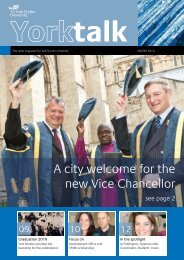
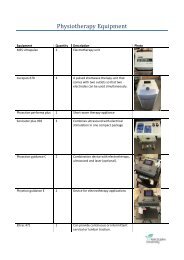
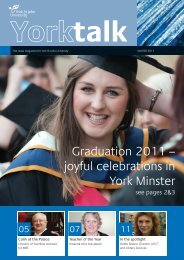

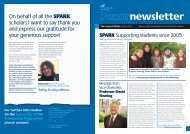
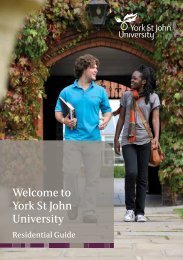

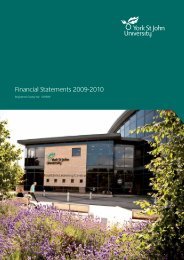


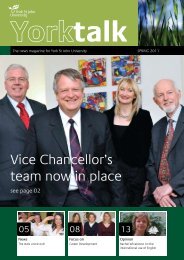

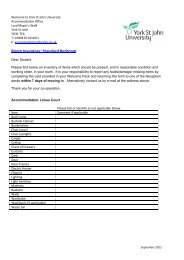
![â'Those [women] who feel strong and hope to find employment, a ...](https://img.yumpu.com/53506972/1/184x260/athose-women-who-feel-strong-and-hope-to-find-employment-a-.jpg?quality=85)
